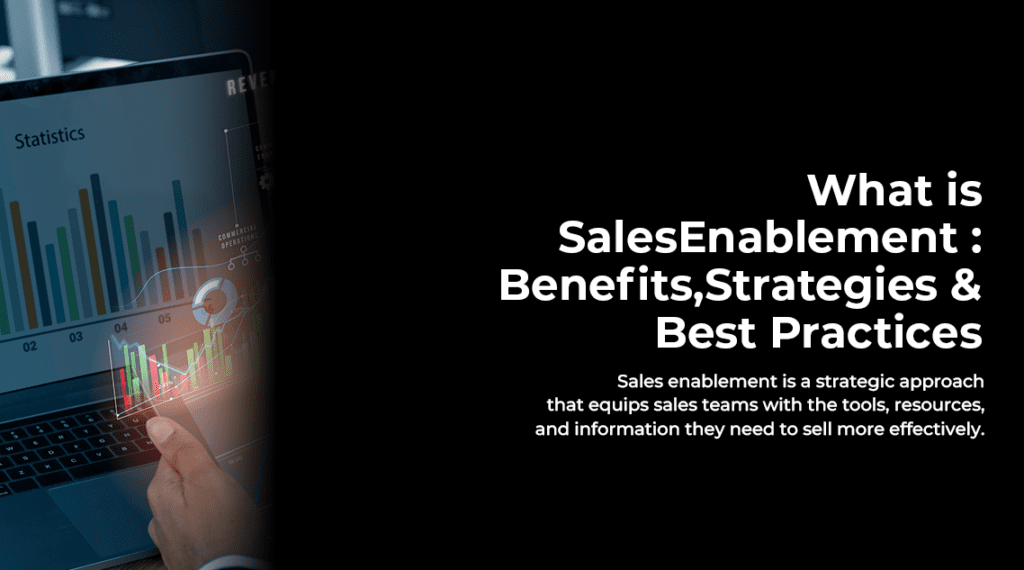Introduction
Sales enablement is a strategic approach that equips sales teams with the tools, resources, and information they need to sell more effectively. It aims to improve the efficiency and productivity of sales professionals by providing them with relevant content, training, and technology.
Sales enablement ultimately empowers sales teams to engage prospects, address their needs, and close deals more effectively, resulting in increased revenue and better customer relationships.
It aligns marketing and sales efforts, ensuring that the sales force has the right resources to succeed in a competitive marketplace.
What Is Sales Enablement?
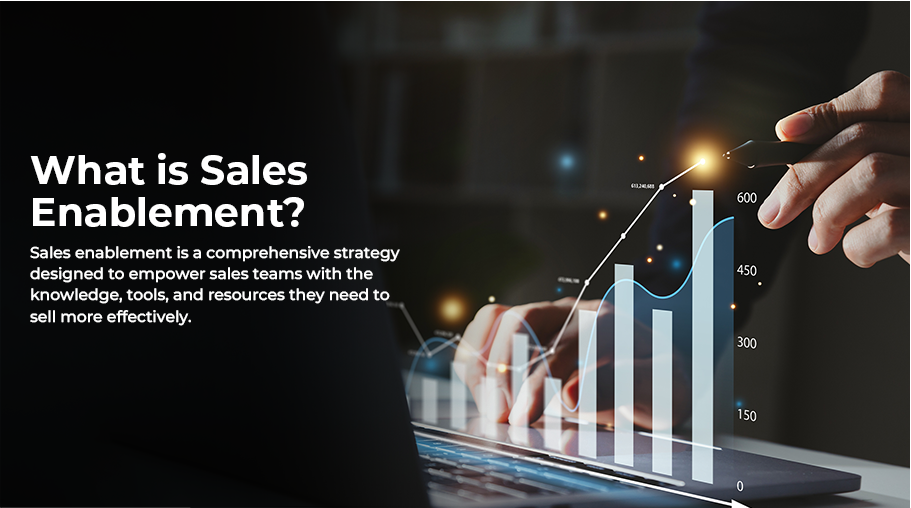
Sales enablement is a comprehensive strategy designed to empower sales teams with the knowledge, tools, and resources they need to sell more effectively. It involves delivering relevant content, training, and technology to sales professionals to enhance their performance.
This approach optimizes the entire sales process by ensuring that representatives have the right information at the right time, can communicate value effectively, and navigate complex sales cycles with confidence.
Key components include content creation and distribution, ongoing training and skill development, utilization of sales technology and tools, refining sales processes for efficiency, and leveraging data and analytics for informed decision-making. Sales enablement aligns sales and marketing efforts, fosters a consistent sales approach, and improves productivity.
It leads to more efficient sales cycles, increased revenue, and stronger customer relationships by helping sales teams engage prospects, address their specific needs, and close deals successfully in today’s competitive marketplace.
Why Do We Need Sales Enablement?
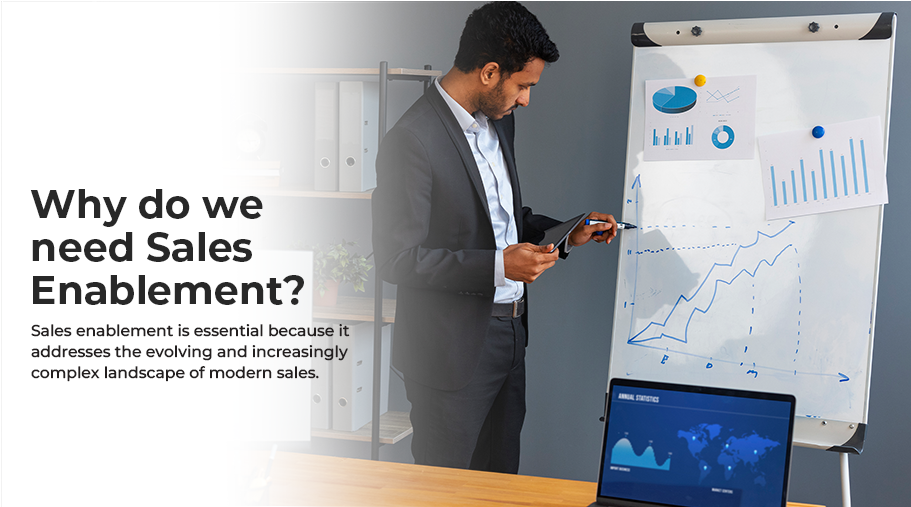
Sales enablement is essential because it addresses the evolving and increasingly complex landscape of modern sales. The need arises from several factors:
1. Information Overload: In today’s digital age, potential buyers are inundated with information. Sales enablement ensures that sales teams can cut through the noise and provide valuable, relevant content to stand out and engage effectively.
2. Changing Buyer Behavior: Buyers now conduct extensive research online before engaging with a salesperson. Sales enablement equips sales teams with insights into buyer behavior and preferences, enabling them to adapt their approach accordingly.
3. Product Complexity: Many industries have seen a rise in the complexity of products and services. Sales enablement provides the knowledge and tools to help salespeople convey the value of these complex offerings.
4. Competitive Landscape: Markets are highly competitive, and customers have numerous options. Sales enablement equips sales professionals to differentiate their offerings and win in competitive situations.
5. Technology Advancements: The integration of sales technology, like CRM systems and analytics, requires training and support. Sales enablement ensures that sales teams can leverage these tools effectively.
6. Efficiency and Effectiveness: In a dynamic sales environment, efficiency is crucial. Sales enablement streamlines processes, providing resources and strategies that lead to better outcomes and, ultimately, more revenue.
What Are Sales Enablement Benefits?
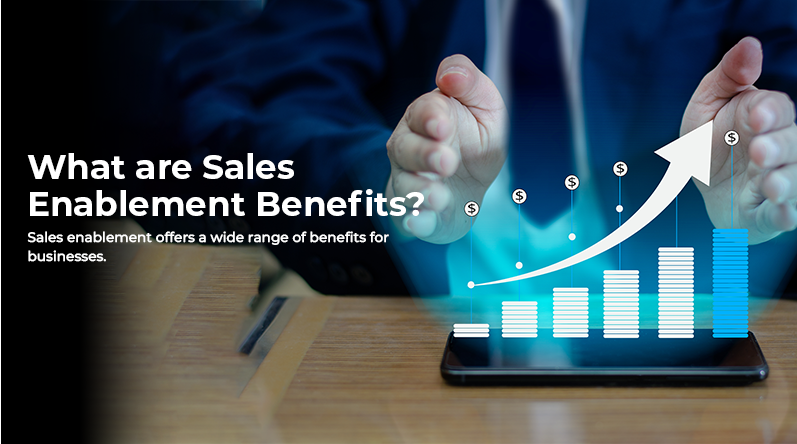
Sales enablement offers a wide range of benefits for businesses:
1. Increased Sales Productivity: By providing sales teams with the right resources and tools, sales enablement enhances efficiency, enabling reps to focus more on selling and less on administrative tasks.
2. Improved Sales Performance: Sales professionals equipped with relevant content and training can better engage with prospects, tailor their pitches, and close deals more effectively.
3. Consistency: Sales enablement ensures a consistent messaging and sales approach across the organization, leading to a stronger brand image and customer experience.
4. Faster Onboarding: New sales team members can quickly get up to speed with comprehensive training and access to sales assets, reducing the time to productivity.
5. Better Customer Insights: Sales enablement leverages data and analytics to provide insights into customer behavior, enabling more personalized interactions and higher customer satisfaction.
6. Alignment of Sales and Marketing: It fosters better collaboration between sales and marketing teams, ensuring that marketing content and lead generation efforts align with sales objectives.
7. Adaptability: Sales enablement helps teams stay agile in response to market changes and emerging trends, allowing them to remain competitive and responsive to customer needs.
8. Increased Revenue: Ultimately, the combined impact of these benefits results in increased revenue through more efficient sales processes and a stronger, more effective sales team.
What Is A Sales Enablement Framework?
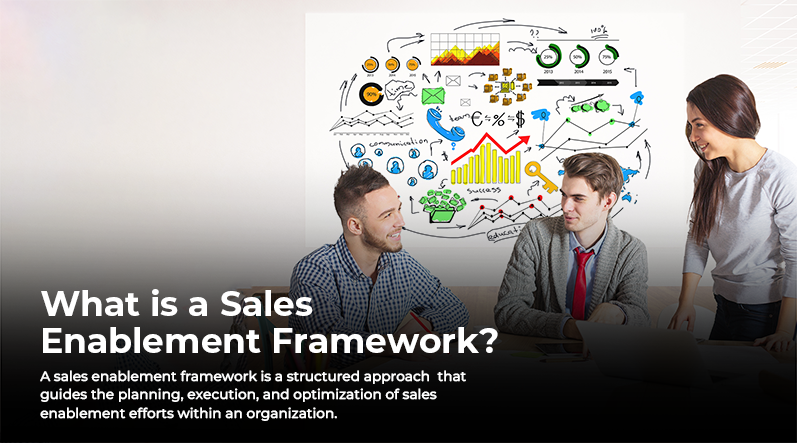
A sales enablement framework is a structured approach that guides the planning, execution, and optimization of sales enablement efforts within an organization. It serves as a roadmap to ensure that sales teams receive the necessary support, resources, and strategies to maximize their effectiveness.
A typical sales enablement framework involves several key components:
1. Assessment: The framework starts with a thorough analysis of the current state of sales operations, identifying strengths, weaknesses, and areas for improvement.
2. Strategy: It outlines the overarching strategy, objectives, and key performance indicators (KPIs) that sales enablement aims to achieve, aligning these with broader business goals.
3. Content and Training: The framework emphasizes the creation and distribution of sales content, including sales collateral and training materials, to educate and empower sales teams.
4. Technology and Tools: It defines the technology stack and tools required for sales effectiveness, such as CRM systems, analytics platforms, and sales automation.
5. Processes: The framework establishes standardized sales processes that incorporate best practices and facilitate seamless collaboration between sales and marketing.
6. Measurement and Feedback: It outlines how success will be measured, involving regular feedback loops to continuously refine and adapt the enablement strategy.
7. Iterative Improvement: The framework encourages an iterative approach, allowing for ongoing adjustments to optimize sales enablement efforts over time.
By providing a structured framework, organizations can systematically enhance their sales capabilities, align sales and marketing, and drive revenue growth.
What Are The Core Components Of Sales Enablement?
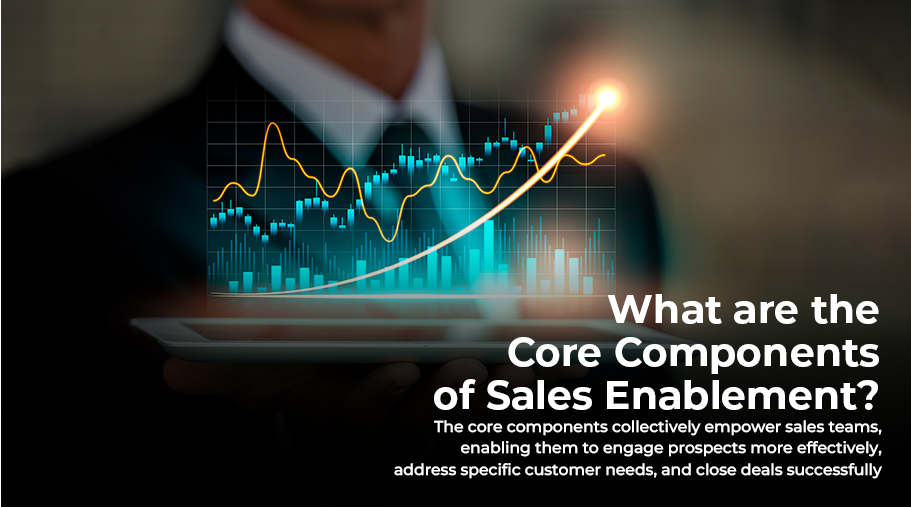
Sales enablement encompasses several core components:
1. Content Creation and Management: Developing and curating sales content like product information, case studies, and sales collateral to support effective communication with prospects and customers.
2. Training and Development: Ongoing training programs to equip sales teams with the knowledge and skills they need to excel, covering product knowledge, sales techniques, and industry understanding.
3. Technology and Tools: Utilizing sales technology, such as CRM systems, sales automation software, and analytics platforms, to streamline processes, track performance, and enhance efficiency.
4. Sales Processes and Methodologies: Defining and optimizing standardized sales processes, ensuring a consistent approach to selling and better collaboration between sales and marketing.
5. Analytics and Data Insights: Leveraging data and analytics to gain insights into customer behavior, measure sales performance, and refine strategies based on real-time feedback.
6. Alignment with Marketing: Collaborating closely with the marketing team to ensure that marketing efforts align with sales objectives, and that marketing content is effectively used in the sales process.
7. Feedback and Iteration: Establishing feedback mechanisms for continuous improvement, enabling the sales enablement program to adapt to changing market conditions and evolving customer needs.
These core components collectively empower sales teams, enabling them to engage prospects more effectively, address specific customer needs, and close deals successfully. The integration of these components improves sales efficiency, fosters better collaboration, and ultimately drives revenue growth.
What Is Sales Enablement Vs Marketing?
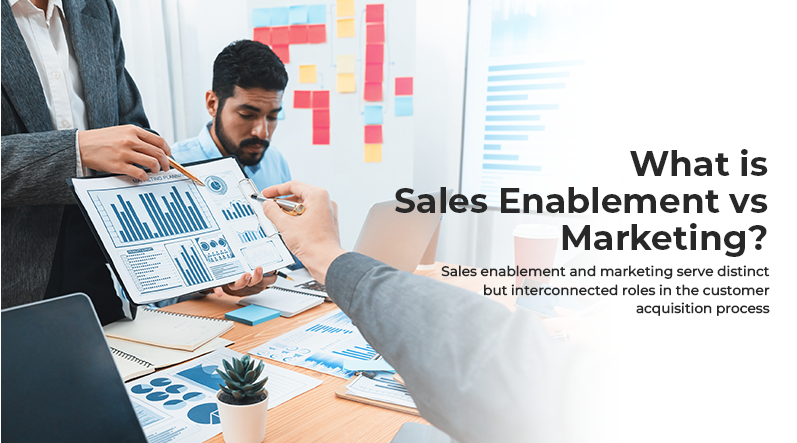
Sales enablement and marketing serve distinct but interconnected roles in the customer acquisition process:
1. Sales Enablement: Sales enablement focuses on equipping sales teams with the tools, resources, and knowledge needed to close deals effectively. It involves training, content creation, and technology support to empower salespeople. Its primary goal is to facilitate more efficient selling and improve the productivity of the sales force.
2. Marketing: Marketing, on the other hand, encompasses a broader set of activities that generate interest, awareness, and leads for a company’s products or services. It includes advertising, branding, lead generation, and content creation to attract and engage potential customers. Marketing aims to create demand and drive prospects into the sales funnel.
While sales enablement and marketing are distinct functions, they must collaborate closely. Sales teams rely on marketing for lead generation and effective messaging, while marketing benefits from sales feedback to refine strategies and content.
Both functions should align their efforts to ensure a seamless transition from lead generation to conversion, creating a cohesive and effective customer acquisition process.
What Is A Sales Enablement Strategy?
A sales enablement strategy is a well-defined plan that outlines how an organization will empower its sales teams with the resources, tools, and knowledge needed to drive success. It involves a systematic approach to improving sales efficiency and effectiveness. Key elements of a sales enablement strategy include:
1. Goals and Objectives: Clear, measurable targets that align with broader business objectives, such as revenue growth, increased win rates, or shorter sales cycles.
2. Audience Understanding: A deep understanding of the sales teams’ needs, as well as the expectations and behaviors of customers and prospects.
3. Content Creation and Management: Strategies for developing and curating sales content, ensuring it’s relevant, accessible, and aligned with the buyer’s journey.
4. Training and Development: Plans for ongoing training and skill development, including product knowledge, sales techniques, and industry understanding.
5. Technology and Tools: Selection and implementation of sales technology, such as CRM systems, to support sales processes and enhance tracking and reporting.
6. Processes and Workflows: The definition and optimization of sales processes, creating a structured and consistent approach to selling.
7. Metrics and Measurement: Key performance indicators (KPIs) to track success and provide data-driven insights for continuous improvement.
A well-crafted sales enablement strategy ensures that sales teams are well-equipped to engage prospects effectively, close deals, and achieve revenue targets in an ever-evolving business landscape.
What Are Sales Enablement Activities : 7 Examples
1. Content Creation: Developing and maintaining a repository of sales materials, including product guides, case studies, and presentations, to help sales teams effectively communicate with prospects.
2. Training Programs: Organizing regular training sessions to enhance product knowledge, sales skills, and market awareness, ensuring that sales professionals are well-prepared to engage with potential customers.
3. Sales Playbooks: Creating structured playbooks that offer salespeople step-by-step guidance on how to approach specific sales scenarios, improving consistency and effectiveness.
4. Technology Integration: Implementing and optimizing sales technology tools, such as CRM systems, to streamline processes, manage customer data, and track performance.
5. Feedback Loops: Establishing channels for sales teams to provide feedback on content, processes, and strategies, enabling continuous improvement and adaptation to changing market conditions.
6. Content Distribution Platforms: Using content management systems to deliver sales collateral to sales teams, ensuring easy access to up-to-date and relevant materials.
7. Competitive Intelligence: Providing sales teams with insights into competitors’ strengths and weaknesses, enabling them to position products or services effectively in the marketplace.
These activities collectively equip sales teams to engage prospects, understand customer needs, and close deals successfully while maintaining a competitive edge. Sales enablement activities foster a collaborative and well-prepared sales force, leading to increased efficiency and revenue growth.
Sales Enablement Best Practices To Try
1. Align Sales and Marketing: Foster close collaboration between sales and marketing teams to ensure consistent messaging and a shared understanding of target audiences. This alignment improves lead quality and accelerates the sales process.
2. Content Personalization: Tailor content to the specific needs and interests of prospects at different stages of the buyer’s journey. Personalized content increases engagement and conversion rates.
3. Continuous Training: Implement ongoing training programs to keep sales teams updated on product knowledge, industry trends, and sales techniques. This empowers them to adapt to evolving customer needs.
4. Sales Playbooks: Develop comprehensive playbooks that provide step-by-step guidance for various sales scenarios. These playbooks help standardize the sales process and improve sales efficiency.
5. Sales Technology Integration: Invest in and optimize sales technology tools, such as CRM systems, to automate routine tasks, provide valuable insights, and enhance data-driven decision-making.
6. Feedback Loops: Establish feedback mechanisms for sales teams to share insights and challenges they face in the field. This feedback loop informs continuous improvement and strategy adjustments.
7. Metrics and KPIs: Define and track key performance indicators (KPIs) to measure the success of sales enablement efforts. Data-driven insights guide future strategies and identify areas for improvement.
By implementing these best practices, organizations can build a strong foundation for effective sales enablement, ultimately leading to more productive sales teams and improved revenue generation.
Sales Enablement KPIs To Track
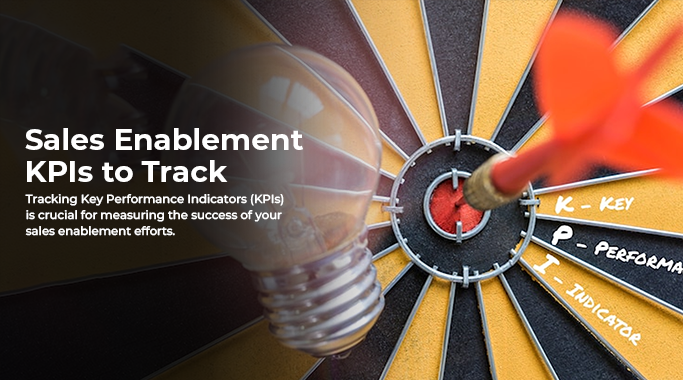
Tracking Key Performance Indicators (KPIs) is crucial for measuring the success of your sales enablement efforts. Some important sales enablement KPIs include:
1. Win Rate: This metric shows the percentage of deals won out of the total number of opportunities. A higher win rate indicates effective sales strategies and customer engagement.
2. Sales Velocity: It measures the time it takes to move a lead from initial contact to closure. Reducing this time means shorter sales cycles and faster revenue generation.
3. Revenue Growth: Monitoring overall revenue growth, both in absolute terms and relative to sales enablement investments, is a direct measure of the impact on the bottom line.
4. Content Engagement: Track how often sales content is accessed and utilized. High engagement indicates the relevance and effectiveness of sales materials.
5. Training Effectiveness: Measure the improvement in sales performance before and after training programs. This KPI assesses the impact of skill development.
6. Lead Conversion Rate: Analyze the percentage of leads that progress through the sales funnel. A higher conversion rate indicates successful lead nurturing and effective sales tactics.
7. Customer Satisfaction: Gauge customer feedback and satisfaction scores, as happy customers are more likely to become repeat buyers and advocates.
These KPIs provide valuable insights into the efficiency and effectiveness of sales enablement efforts, helping organizations refine their strategies and drive better results.
7 Sales Enablement Tools To Try In 2024
1. Highspot: Highspot is a comprehensive sales enablement platform that offers content management, training, and analytics. It provides personalized content recommendations, ensuring sales teams have access to the most relevant materials for each prospect.
2. Seismic: Seismic is known for its advanced content management and analytics capabilities. It enables sales teams to create, manage, and distribute content efficiently, while its analytics help track content performance and engagement.
3. Showpad: Showpad offers content management, sales training, and robust analytics. It emphasizes interactive and visually engaging content that’s easy for sales teams to use in customer interactions.
4. HubSpot Sales Hub: HubSpot’s Sales Hub includes a range of sales enablement features, such as CRM integration, email tracking, and automated follow-ups. It’s a user-friendly solution that simplifies many sales tasks.
5. Chorus.ai: Chorus.ai is a conversation intelligence platform that records, transcribes, and analyzes sales calls and meetings. It provides insights into conversation quality, helping sales teams improve their pitch and objection handling.
6. Brainshark: Brainshark offers video-based sales training and coaching. It allows organizations to create and share video content for sales training, and it tracks how sales reps engage with the material.
7. Gong.io: Gong.io is a conversation analytics and salesforce coaching platform that helps sales teams improve their call and meeting performance. It provides insights into successful sales conversations and offers coaching recommendations.
These tools can help organizations streamline their sales enablement efforts, improve content management, provide effective training, and gain valuable insights to enhance their sales strategies in 2024.
How Can Sales Enablement Help You Decrease Sales Cycle In B2B SaaS?
Sales enablement in B2B SaaS can significantly reduce sales cycles by:
1. Content Optimization: Sales enablement ensures that sales teams have easy access to highly relevant and up-to-date content, allowing them to effectively address prospect concerns and accelerate decision-making.
2. Training: Continuous training programs offered through sales enablement keep sales reps informed about the product and its value proposition. This knowledge empowers reps to have more compelling and efficient conversations with prospects.
3. Process Streamlining: Sales enablement establishes well-defined sales processes, eliminating unnecessary steps and ensuring that reps focus on high-impact activities, which can significantly speed up the sales cycle.
4. Technology Integration: Sales enablement tools and CRM systems help automate routine tasks, track prospect interactions, and provide insights into customer behavior, enabling reps to prioritize leads more effectively and close deals faster.
5. Feedback Loops: Sales enablement encourages feedback from the field, allowing for rapid adjustments to strategies and content based on real-world interactions, making the sales process more responsive to customer needs.
6. Playbooks: Sales enablement develops and disseminates sales playbooks, guiding reps on the most effective strategies for different scenarios, helping them navigate complex sales cycles efficiently.
By combining these elements, sales enablement empowers sales teams to engage with prospects more effectively, address their specific needs, and close deals faster in the B2B SaaS sector.
Conclusion
In today’s competitive business landscape, effective sales enablement is an indispensable strategy for organizations aiming to boost sales productivity and revenue. It empowers sales teams with the right tools, resources, and knowledge to engage prospects, articulate value, and close deals efficiently. Sales enablement bridges the gap between marketing and sales, ensuring that the two departments work in harmony to achieve common goals.
Key components of sales enablement include content creation, continuous training, technology integration, well-defined sales processes, analytics, alignment with marketing, and feedback loops. These elements collectively contribute to increased sales productivity, improved performance, and enhanced customer satisfaction.
Moreover, tracking relevant KPIs allows organizations to measure the impact of their sales enablement efforts, identifying areas for improvement and strategic adjustments. In B2B SaaS, for instance, sales enablement can lead to shorter sales cycles, more informed sales reps, and, ultimately, increased revenue.
As we move into an increasingly data-driven and customer-centric era, sales enablement will continue to play a pivotal role in shaping the success of sales teams, fostering customer relationships, and driving business growth. It’s a strategic imperative for any organization seeking to thrive in a competitive marketplace.
For in-depth insights and expert advice on SaaS marketing, visit Revvgrowth.com and explore our comprehensive blogs.

